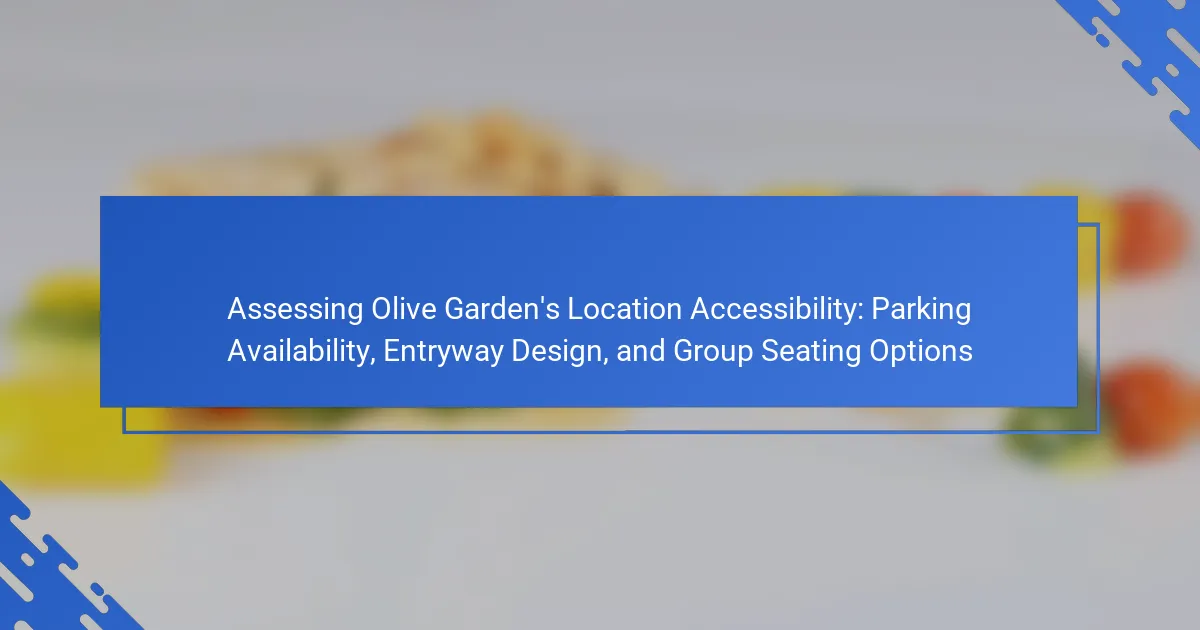Olive Garden is a restaurant chain whose location accessibility is shaped by several critical factors, including parking availability, entryway design, and proximity to public transportation. Adequate parking spaces ensure easy access for customers, while thoughtfully designed entryways support smooth entry and exit, catering to individuals with disabilities. Additionally, locations situated near public transport hubs improve accessibility for those who do not drive. The interior layout of Olive Garden restaurants is also designed to accommodate group seating, facilitating dining experiences for larger parties. These elements collectively enhance the overall dining experience for patrons.

What factors contribute to Olive Garden’s location accessibility?
Olive Garden’s location accessibility is influenced by several key factors. These include parking availability, entryway design, and proximity to public transportation. Ample parking spaces allow easy access for customers. Well-designed entryways facilitate smooth entry and exit for patrons, including those with disabilities. Locations near public transport hubs enhance accessibility for non-drivers. Additionally, the layout inside restaurants accommodates group seating, making it easier for larger parties to dine together. These factors collectively contribute to a positive dining experience at Olive Garden.
How does parking availability impact customer access to Olive Garden?
Parking availability significantly impacts customer access to Olive Garden. Adequate parking spaces facilitate easier access for patrons. Customers are more likely to visit if they can park conveniently. Limited parking may deter potential diners due to frustration or inconvenience. Studies show that restaurants with ample parking experience higher customer traffic. A survey indicated that 70% of customers consider parking availability when choosing a dining location. Thus, parking plays a crucial role in the overall accessibility of Olive Garden.
What types of parking facilities are typically available at Olive Garden locations?
Olive Garden locations typically offer a variety of parking facilities. Most locations provide on-site parking lots. These lots usually accommodate both standard and accessible parking spaces. Many Olive Garden restaurants also feature designated areas for larger vehicles. Some locations may offer valet parking services during peak hours. The availability of parking facilities can vary by location. However, most Olive Garden restaurants prioritize convenient access for guests. This ensures a positive dining experience.
How does parking capacity vary across different Olive Garden locations?
Parking capacity at Olive Garden locations varies significantly. Some locations feature expansive parking lots accommodating over 100 vehicles. Others may have limited parking, with capacities around 30 to 50 vehicles. Factors influencing parking capacity include location size, regional demand, and local zoning regulations. For instance, Olive Gardens in urban areas often face space constraints, leading to reduced parking availability. Conversely, suburban locations typically offer more extensive parking facilities. This variance ensures that each Olive Garden location adapts to its specific environment and customer needs.
What role does entryway design play in accessibility at Olive Garden?
Entryway design at Olive Garden plays a crucial role in ensuring accessibility for all guests. It includes features such as ramps, wide doors, and automatic openings. These elements facilitate easy entry for individuals with mobility challenges. Clear signage is also part of the design, guiding guests effectively. The layout minimizes obstacles, allowing smooth movement from the parking area to the dining space. Compliance with accessibility standards is essential for providing an inclusive environment. This design approach enhances the overall dining experience for everyone.
How are entryways designed to accommodate all customers?
Entryways are designed to accommodate all customers by ensuring accessibility for individuals with varying needs. They often feature automatic doors for ease of entry. Additionally, entryways include ramps to assist those with mobility devices. Signage is clear and visible, aiding navigation for all guests. The layout allows for ample space to avoid congestion. Furthermore, lighting is strategically placed to enhance visibility. These design elements comply with accessibility standards, such as the Americans with Disabilities Act (ADA). This approach ensures a welcoming environment for everyone.
What specific features enhance entryway accessibility for individuals with disabilities?
Features that enhance entryway accessibility for individuals with disabilities include ramps, automatic doors, and wide doorways. Ramps provide a smooth transition for wheelchair users. Automatic doors allow for hands-free entry, accommodating those with mobility challenges. Wide doorways enable easy passage for wheelchairs and mobility aids. Additionally, tactile paving can guide visually impaired individuals. Adequate lighting enhances visibility and safety at entry points. Clear signage should indicate accessible routes and features. These elements collectively improve access and usability for all individuals.
How do group seating options affect the dining experience at Olive Garden?
Group seating options at Olive Garden enhance the dining experience by accommodating larger parties effectively. These options provide a more social atmosphere, allowing guests to interact comfortably. The layout of group seating promotes engagement among diners, fostering a sense of community. Additionally, these arrangements can lead to quicker service for larger groups, as servers can manage multiple guests more efficiently. Olive Garden’s design typically includes spacious tables and booths that cater to family gatherings. This setup is particularly beneficial during special occasions, where group dining is common. Overall, group seating options significantly improve the overall enjoyment of the dining experience at Olive Garden.
What types of group seating arrangements are available at Olive Garden?
Olive Garden offers several types of group seating arrangements. These include large tables that accommodate families and friends. They also provide semi-private dining areas for more intimate gatherings. Additionally, many locations feature flexible seating options to adjust to group sizes. Reservations are recommended for larger parties. Olive Garden aims to create a comfortable dining experience for groups. This is reflected in their layout and seating configurations.
How does group seating capacity differ between Olive Garden locations?
Group seating capacity varies by Olive Garden location. Some locations can accommodate larger groups of up to 100 guests. Other sites may only fit smaller parties of around 30 to 50 guests. This variation is influenced by the restaurant’s overall layout and design. Additionally, regional demand and local zoning laws can affect capacity. Olive Garden aims to provide flexible seating arrangements to meet customer needs. Specific seating arrangements can be confirmed by contacting individual locations directly.
What are common challenges faced regarding accessibility at Olive Garden?
Common challenges regarding accessibility at Olive Garden include limited parking options for individuals with disabilities. Many locations may not have enough designated accessible spaces. Entryway designs can also pose difficulties, as some restaurants may have steps or heavy doors. Additionally, the layout inside may not accommodate wheelchairs effectively. Group seating options can be restrictive for larger parties requiring accessible arrangements. These challenges can hinder the overall dining experience for individuals with mobility issues.
How do customers perceive the accessibility of Olive Garden locations?
Customers generally perceive Olive Garden locations as accessible. Many report convenient parking options at most sites. Entryways are often designed to accommodate individuals with mobility challenges. Additionally, the layout inside is typically spacious, allowing for easy navigation. Group seating options are available, which enhances accessibility for larger parties. Customer feedback often highlights these aspects positively. Overall, accessibility is a key strength noted by patrons.
What improvements have been suggested for enhancing accessibility at Olive Garden?
Improvements suggested for enhancing accessibility at Olive Garden include increasing accessible parking spaces. This would ensure closer proximity for individuals with mobility challenges. Additionally, enhancing entryway design by installing automatic doors is recommended. Automatic doors facilitate easier access for those with physical disabilities. Furthermore, providing clear signage throughout the restaurant can assist visually impaired guests. Implementing accessible seating arrangements for larger groups is also suggested. These arrangements would accommodate patrons with varying needs. Lastly, staff training on accessibility awareness is crucial. This training ensures that all employees are equipped to assist guests effectively.
What best practices can enhance location accessibility at Olive Garden?
Implementing designated accessible parking spaces enhances location accessibility at Olive Garden. These spaces should be located near the entrance. Clear signage indicating accessible routes is also essential. This helps guide individuals with mobility challenges. Installing automatic door openers facilitates easier entry for all guests. Ensuring that pathways are free of obstacles improves navigation within the restaurant. Offering accessible seating options accommodates groups with varying needs. Staff training on accessibility awareness enhances customer service for individuals with disabilities. Regular assessments of accessibility features ensure compliance with standards and customer satisfaction.
The main entity of the article is Olive Garden, specifically focusing on its location accessibility. The article examines critical factors that contribute to accessibility, including parking availability, entryway design, and group seating options. It highlights how adequate parking and well-designed entryways enhance customer access, particularly for individuals with disabilities. Additionally, the article discusses the variety of group seating arrangements available and common challenges faced regarding accessibility, along with suggested improvements and best practices for enhancing the dining experience at Olive Garden.
